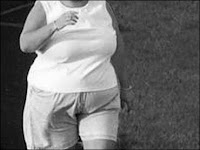 Study Gives The Skinny On "Fit And Fat"
Study Gives The Skinny On "Fit And Fat"Shows Exercise Helps, But Doesn't Eliminate An Overweight Woman's Heart Disease Risk
(WebMD) Regular exercise has long been touted as the key to a healthy heart, but a new study shows it is unlikely to fully reverse a woman's chances of heart disease if she is carrying extra weight.
Researchers report in the April 28 issue of Archives of Internal Medicine that although physical activity definitely helps improve cardiovascular health, such exercise does not "eliminate the negative effects of being overweight."
The findings underscore the importance of being fit and trim and cast doubt on the newer notion that it's possible to be "fit and fat." Both obesity and a sedentary lifestyle are modifiable risk factors for coronary heart disease. Heart disease is the leading cause of death in women in the United States.
Which exerts more influence in one's risk of heart disease: exercise or weight? There's no clear-cut answer. Fat cells release chemicals that can speed up the hardening of arteries, trigger inflammation, and lead to blood clots. Exercise counteracts these potentially heart-damaging processes by improving blood vessel function.
The new study, conducted by Amy R. Weinstein, M.D., MPH, of Beth Israel Deaconess Medical Center in Boston, and colleagues helps establish the combined effect of the two risk factors. The study involved 38,987 women from the Women's Health Study. Each woman provided information about her height, weight, exercise routine, medical history, and other health habits at the beginning of the study. About half of the women were considered to be of normal weight. A little less than one-third of the women were overweight, and 18 percent were obese. According to the Surgeon General's guidelines, 34 percent were considered physically active.
During about 11 years of follow-up, 948 women developed heart disease. According to the researchers, body mass index (BMI) and exercise both individually contributed to its development. A BMI between 25 and 29 is considered overweight. A BMI of 30 or above is considered obese.
The study shows that:
- Active women of normal weight had the lowest heart disease risk.
- Heart disease risk was slightly higher for women of normal weight who were inactive.
- Active women who were overweight or obese were more likely to experience
heart disease during follow-up than active normal-weight women, but less likely than their inactive counterparts. - The highest heart disease risk was seen among the most inactive, heaviest
women.
"Even high quantities of physical activity are unlikely to fully reverse the risk of coronary heart disease in overweight and obese women without concurrent weight loss ," the authors conclude in the journal article. "Regardless of body weight, these data highlight the importance of counseling all women to participate in increasing amounts of regular physical activity and maintaining a healthy weight to reduce the risk of coronary heart disease."
Source: here
© 2008 Thanks for taking the time to read my blog. Please feel free to peruse my blog for more great content.
My Other Websites: Are Your Vitamins Safe? Whole Food Nation Affiliate Link

No comments:
Post a Comment